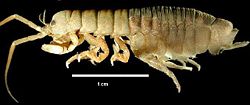Isopoda
| Isopods | ||||||||||
|---|---|---|---|---|---|---|---|---|---|---|
 Eophreatoicus, a freshwater isopod from Australia
| ||||||||||
| Scientific classification | ||||||||||
| ||||||||||
|
Anthuridea |
Isopoda is a diverse and widely distributed order of aquatic and terrestrial malacostracan crustaceans, characterized by a generally small, dorsoventrally flattened body, a pair of maxillipeds, two large antennae and one small pair, a cephalic shield rather than a carapace, unstalked compound eyes, and many legs except in the parasitic forms. With about 10,000 species placed into ten suborders, Isopoda is very diverse, and includes marine, freshwater, terrestrial, and parasitic forms. The presence of terrestrial forms, such as the family pillbugs and woodlice, is atypical for crustaceans.
Found worldwide in many kinds of habitats
Overview and description
The isopods (order Isopoda) are part of the Malacostraca, a class (or subclass) of crustaceans that includes such familiar members as crabs, lobsters, and shrimps. Malacostracans are characterized by having trunk limbs differentiated into an abdominal series and thoracic series and by having a maximum of 19 pairs of appendages.
Members of the order Isopoda are typically flat or at least somewhat dorsally ventrally flattened As with other crustaceans, they have three distinct body parts: Head (or cephalon), thorax (or pereon), and abdomen (or pleon), but the cephalon is fused with the first segment of the thorax. The head of isopods have unstalked compound eyes, mouth, one pair of antennulae (first antenna, vestigial in isopods), one pair of large antennae, and four pairs of mouthparts (mandibles, maxillulae, maxillae, and maxillipeds). Maxillipeds are appendages modified to function as mouthparts and appear as on the posterior and ventral edge of the cephalon but actually are the first thoracic appendages (Keable et al. 2003; Mertz 2004).
Species that are non-parasitic have at least 14 walking legs (pereopods) on the thorax, one pair per each of the seven segments (Mertz 2004). (The first thoracic segment, with maxillipeds, gives a total of eight thoracic segments.) The legs of the parasitic forms are either absent or developed only one one side of the body (Mertz 2004). They lack a carapace to protect the internal organs but do have a cephalic shield (Mertz 2004). Isopods ahve paired appendages at the end of the abdomen called uropods.
Isopods are generally small, ranging from about 5 to 15 millimeters (0.2—0.6 inches) (Mertz 2004). However, there also are species that are considerably smaller, about 0.5 millimeters (0.02 inches) and larger, reaching 50 centimeters (19.7 inches) in the case of Bathynomus giganteus) (Mertz 2004). Isopods vary in color from dark gray to white, with and without pattern.
Distribution and habitat
Isopoda is one of the most diverse orders of crustaceans, with many species living in a wide variety of environments. They have a worldwide distribution and
but are most common in shallow marine waters. Unlike most crustaceans, isopods are successful on land (suborder Oniscidea, woodlice, which also includes sea slaters), although their greatest diversity remains in the deep sea (suborder Asellota). There are also several parasitic species within the genus Cymothoa, commonly known as "tongue-biters" for their habit of nibbling off fishes' tongues and attaching themselves to the floor of the host's mouth. The isopods are an ancient group with fossils known from the Carboniferous (suborder Phreatoicidea, family Paleophreatoicidae) that only differ slightly from modern southern hemisphere freshwater phreatoicideans. There are 4000 known species[1].
Other Names
Various colloquial names for assorted Isopoda include Woodlouse, Roly-Poly, sowbug, and potato bug. They are also called Pill Bugs.
See also
- Giant isopod
ReferencesISBN links support NWE through referral fees
- ↑ Walters, Martin & Johnson, Jinny. The World of Animals. Bath, Somerset: Parragon, 2007.
Australian Isopoda: Families
S.J. Keable, G.C.B. Poore & G.D.F. Wilson http://www.crustacea.net/crustace/isopoda/glos.htm Australian Museum, 2003
External links
- Isopoda fact sheet - Guide to the marine zooplankton of south eastern Australia
- Smithsonian Institution World List of Marine, Freshwater and Terrestrial Isopod Crustaceans
- Buz Wilson's Isopod Sites Page
- suborder Phreatoicidea
- suborder Asellota
- suborder Oniscidea
- Prof. Chuck Holliday's Research Page, Prof. Chuck Holliday, Dept. of Biology, Lafayette College. Contains links to articles on osmoregulation in isopods and other crustaceans.
- Australian Isopoda
Credits
New World Encyclopedia writers and editors rewrote and completed the Wikipedia article in accordance with New World Encyclopedia standards. This article abides by terms of the Creative Commons CC-by-sa 3.0 License (CC-by-sa), which may be used and disseminated with proper attribution. Credit is due under the terms of this license that can reference both the New World Encyclopedia contributors and the selfless volunteer contributors of the Wikimedia Foundation. To cite this article click here for a list of acceptable citing formats.The history of earlier contributions by wikipedians is accessible to researchers here:
The history of this article since it was imported to New World Encyclopedia:
Note: Some restrictions may apply to use of individual images which are separately licensed.